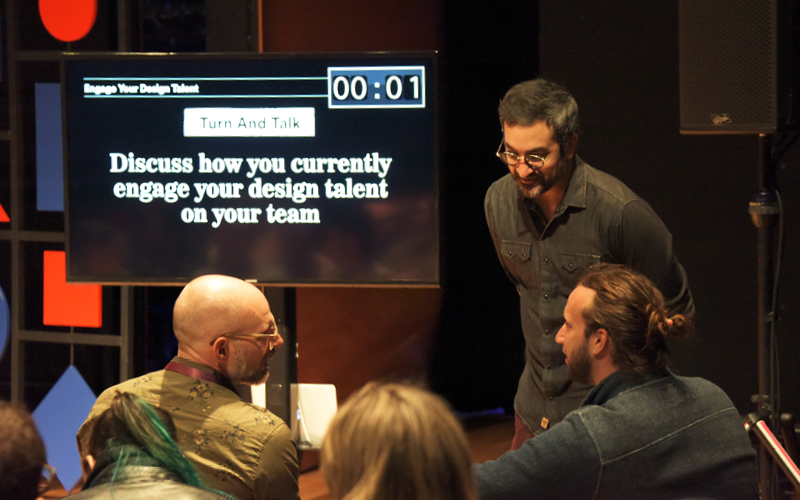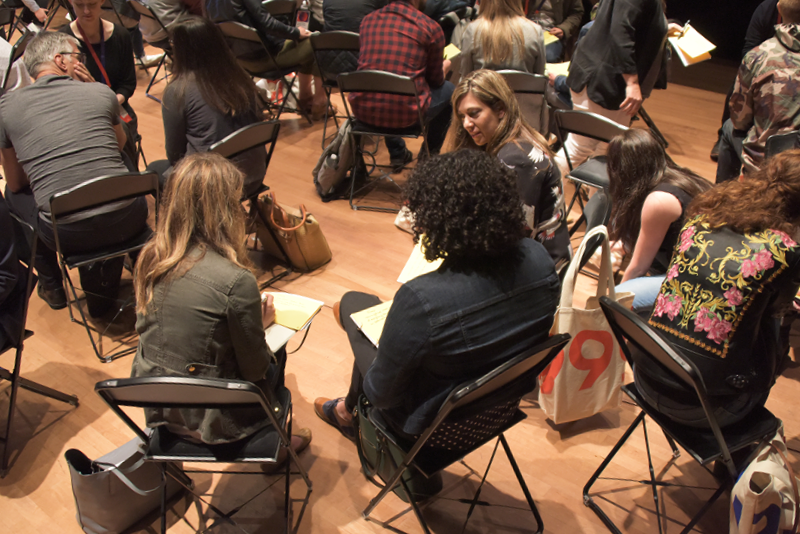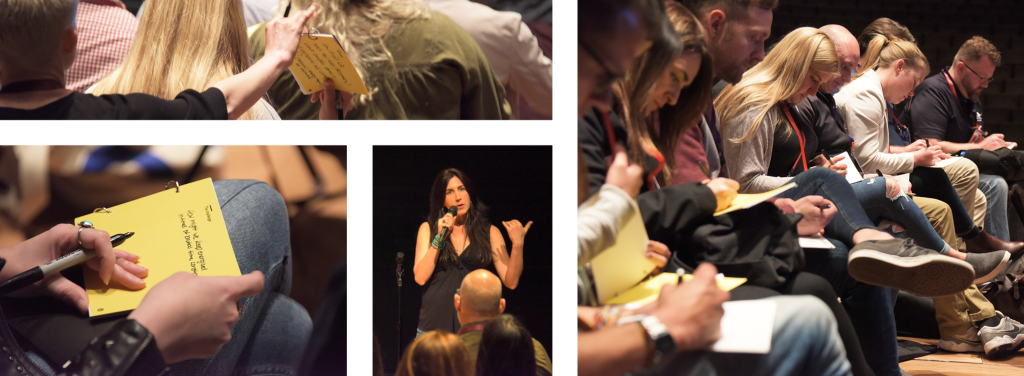As design educators, we at General Assembly prepare students for their careers — but how can we ensure designers continue to grow their skills beyond the classroom? Industry-leading work emerges from teams that persistently enrich themselves by fostering new skill sets and perspectives. But between deadlines, client fire drills, and day-to-day trivialities, a focus on growth can often be put on the back burner. In the long-term, this can result in uninspired designers who don’t grow to their full potential, and teams that opt for the easy way out instead of taking on risks, challenges, and explorations that drive innovation.
When Adobe approached General Assembly about leading a session at the 99u Conference — an annual gathering for creative professionals to share ideas and get inspired to help shape the future of the industry — we knew it would be a great opportunity to guide leaders in creating natural spaces for learning within their teams and workflows.
In our sold-out session “Onboard, Engage, Energize: Tactics for Inspiring a Crack Design Team,” Tyler Hartrich, faculty lead of GA’s full-time User Experience Design Immersive course, and Adi Hanash, GA’s former head of Advanced Skills Academies, shared insights on how directors and managers can structure spaces for learning within their teams, and encourage new approaches to problem-solving. The presentation was developed in collaboration with Senior Instructional Designer Eric Newman and me, GA’s director of product design.
At the event, we outlined the following five ways leaders can encourage their teams (and themselves) to keep learning and improving throughout their careers, including an exercise to spur creativity, reflection, and action. Read on to learn more, and find out how you can perform the exercise with your own team.

1. Foster Creative Design Inspiration
Some of the most valuable learnings come out of failure, so managers should create a safe space for experimentation. By fostering a design culture that values iteration and improvement, teammates can continually learn from one another. And by encouraging teams to always be curious and seek out better ways to engage tools and processes, workflows will constantly improve. Individuals’ skill sets should be ever-evolving, and leaders can encourage this by incentivizing professional development opportunities wherever possible.
2. Champion unique perspectives and diverse backgrounds
The diverse experiences that make up each person — and a team as a whole — can widen designers’ ability to understand different perspectives, and approach their work in a way that is truly unique. While we should always think of the user above all, use the following strategies to encourage designers to leverage their personal and professional histories and distinct perspectives to add to the larger idea base when solving problems.
- Take on challenges with the understanding that the collective is stronger than the individual.
- When hiring, augment your team by looking at the “full design hire” — select contributors not just with talent and skill, but with backgrounds and points of view that are different from those already on the team.
- Continually encourage team members to dive deep into the areas that interest them, which will help them build upon their experiences and perspectives.

3. Challenge one another creatively
When teams are energized and inspired, the work will benefit — so carve out time for your team to flex their creative muscles.
- Routinely provide constructive criticism.
- Create a space for regular team hackathons, and encourage solving real and fictitious challenges.
- Attend conferences and workshops.
- Push everyone on your team to research and explore new topic areas.
4. Encourage thought leadership
It’s important for designers to develop thoughtful perspectives in order to produce smart, effective, and meaningful work. One way to strengthen and refine those points of view is to share them with others. Embolden your team to engage as thought leaders in the industry by sharing designs, theories, and perspectives through social media and blog posts, conversations with the community, and speaking at industry events. Not only will this sharpen their opinions, but it inherently provides designers with solid writing and presentation skills. It also underlines for everyone how much their perspectives are valued.
5. Tackle the tough stuff through a collaborative exercise
At the 99u Conference, our group of 60 participants — which represented 47 companies — embarked on the following exercise to identify ways to solve unique challenges and motivate their teams. By pulling from many of the ideals defined throughout the presentation, the activity melded collaboration with unique individual perspectives toward problem-solving, establishing a safe space for humility, curiosity, and ideation. It also encouraged participants to think like a UX designer by encompassing the values of flexibility, empathy, and adaptability.

In the exercise, attendees reviewed and suggested ideas for nearly a dozen discrete challenges directors and managers face within their design teams. Most meaningfully, every attendee left the room not only with a booklet full of solutions to their own unique issue, but tools to employ the exercise within their own teams to help inspire and advise around future challenges.
Here’s how you can conduct a similar exercise with your team. These instructions are for a group of 10 or more, but you can adapt it for fewer participants.
- Give each participant a stack of cards: one yellow, 10 white, and one blue. Keep each card stack together with a clip or ring, and number each set for anonymity.
- Have each participant write on their yellow card a problem or challenge in their workspace or team for which they’d like suggested solutions. Write the problem or challenge beginning with a “How might we…?” statement, e.g., “How might we practice new approaches to the design process?” “How might we create time for creative challenges when we already work within significant time constraints?”
- Pass the stacks around. Have participants read the problem on the yellow card they received, then provide a solution, idea, or inspirational note on one of the white cards in the set. After one minute, ask participants to pass the stack to the person on their right.
- Repeat this nine more times, so each person provides a unique idea for 10 different challenges, and each different challenge receives 10 unique ideas.
- Divide participants into small groups and have them read through each stack and discuss the challenges and solutions provided. Groups should star the best solutions, and write additional notes and ideas on the blue card. This results in each problem getting ideas that are both individual-sourced and group-sourced.
- Groups can then share with the whole team a challenge and set of solutions they found particularly meaningful.
- Give card stacks back to their original owner, and let everyone get inspired by the many suggestions to solving their unique challenge!
We’re honored that General Assembly could be a part of the renowned 99u Conference, and were excited to advise creative leaders on how to best shape and grow every designer on their teams. With the right guidance around how to structure successful learning environments, together we can shape the future of our industry and each new generation of designers.
Learn more about Design Opportunities at GA
Foster creative design principles to unleash boundless creativity within teams and individuals. At General Assembly, we encourage our students and clients to embark on a path of lifelong learning as the in-demand skills of tomorrow are constantly evolving.
Contact us to learn more about our talent and training solutions today.
***
At General Assembly, learn how to build seamless products that customers will love. Make your company’s teams more efficient and cross-functional through expert-led training in user experience design, visual design, product management, and more. Through our innovative training and hiring programs, create effective teams with the right mix of talent needed to move your business forward. For individuals, learn human-centered design in our full-time or part-time UX design courses, or get started for free with an Intro to UX livestream
